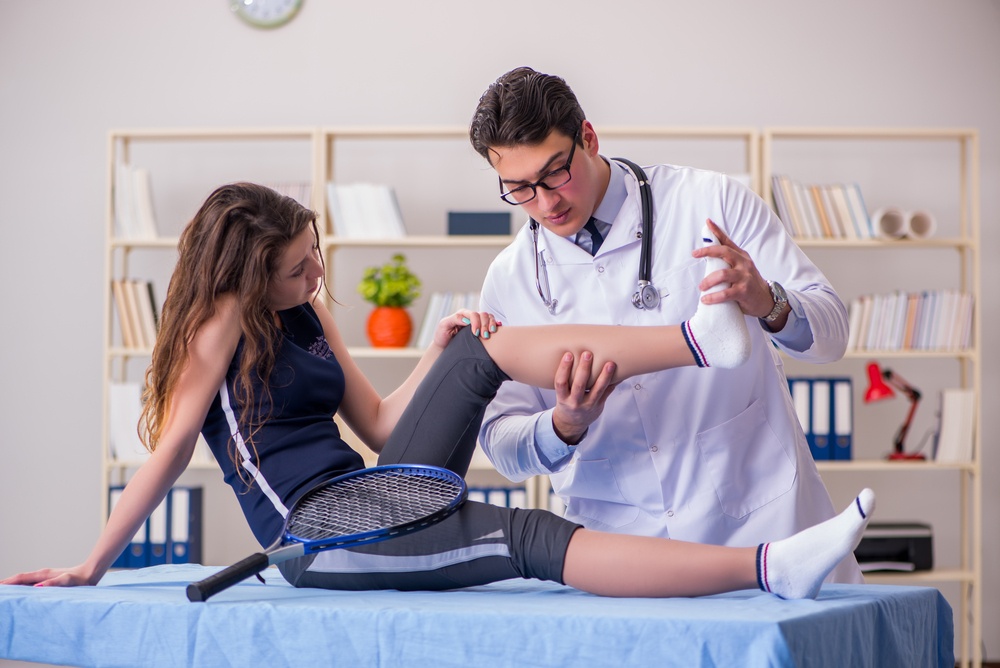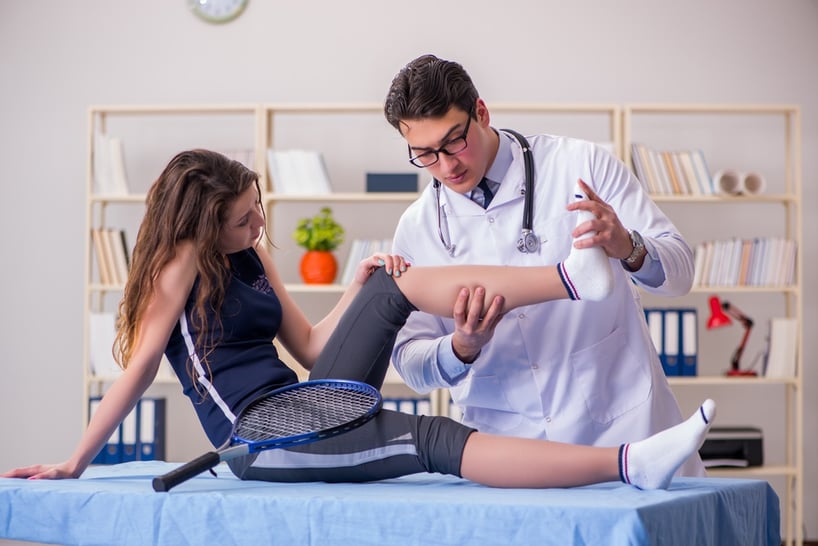Knee Sprains: Prevention and Treatment
November 16th, 2017 | 5 min. read


A knee sprain is a sudden overstretching of one of the ligaments of the knee, leading to a tear, inflammation, and pain. Knee sprains often affect the ACL or the PCL—the two ligaments that guide the front/back movement of the lower leg. Less often, knee sprains affect the MCL or LCL, which are the ligaments that run along the inner and outer sides of the knee.
Knee sprains are very common. According to the Society for Academic Emergency Medicine, this injury affects about 2.3 out of every 1000 Americans. The most commonly injured group is young athletes between the ages of 15 and 19, and they usually sprain or strain their knees playing basketball and football (males) or soccer and basketball (females).
With so many young people in Texas participating in sports today, how can athletes protect their knees and prevent sprains? And non-athletes as well—how can you keep your knee ligaments safe from sprains?
Knee Sprain Risk Factors and Causes
One of the best ways to avoid any injury is to be aware of its causes and risk factors. What are the causes and risk factors of knee sprains?
Most of the time, a knee sprain is the result of a sudden movement or force.
Common causes of knee sprains include:
- Hyperextending the knee. When you kick or straighten your leg, if the lower leg moves past its normal range of motion for the knee joint, you may damage your ACL. The same effect can be caused by something hitting your knee hard, pushing it backward while your lower leg remains planted and straight (for example, if you’re tackled in football). Hyperextension can also happen if someone kicks your lower leg or something strikes you in the calf from behind.
- Impact forces to the outside of the knee. Sideways blows from tackles, or being struck by a moving object, can cause MCL sprains; for example, if you’re kicked in the outside of the leg or hit by a car while crossing the street. Hard falls may also cause damage.
- Pivots and twists. When your feet are planted, any sudden changes in direction can sprain or wrench the ACL or MCL.
- Bad landings. Landing awkwardly after a jump can sprain the ACL. Skiers, ski jumpers, and basketball players often sustain this type of knee sprain.
- Falls and accidents. Any sort of impact from falling can wrench, twist, or strike the knee with a great deal of force, damaging any of the four ligaments.
Are any of these common knee sprain causes likely to affect you? Possibly, if you have the risk factors.
Risk factors for knee sprain include:
- Athletic activity. Especially if you’re a young athlete or student athlete, and particularly if you ski, dance, cheer, or play football, basketball, or soccer. Wrestlers are also at risk for knee injury because they fall onto their knees and sides frequently.
- ACL injury in females is more common due to factors that researchers are still trying to understand.
- Skipping cool downs, warm ups, and stretching. Not properly conditioning and before and after workouts can lead to tissue injury of all kinds, including sprains.
- Weekend warrior syndrome. Do you only participate in sports on the weekends, but are mainly sedentary during the week? If so, your muscles, tendons, and ligaments may be tight or “cold,” and you may be more prone to sudden overstretching and injury when you do get up and get active. Weekend warriors need to take extra care to stay in condition between major workout sessions.
Prevention of knee sprains
Preventing a knee sprain is largely a matter of keeping your knees, legs, and hips in good condition. If your form and posture are correct and your muscles are warmed up and strong, your knees are better protected from all kinds of injury, including sprains.
You can keep your knees safer by:
- Warming up before workouts
- Cooling down after high-intensity workouts
- Stretching regularly to keep your muscles, tendons, and ligaments loose and responsive
- Ramping up your exercise or training regimen gradually; don’t do too much too soon; runners training for marathons, for example, should have a program in place that allows for gradual mileage increases, intervals, and rest days
- Staying hydrated; dehydration is a major contributor to sports injuries
- Keeping your leg muscles strong, especially the quadriceps and hamstrings (front band back of the thigh); conditioned legs help to support the knee and keep it stable
- Working with a trainer, coach, or physical therapist who can advise you about safe ways to work out to protect your knees
Checking your equipment and environment helps, too. Exercising on uneven ground (for example, running on a soccer field full of rocks or gopher holes) is an easy way to twist an ankle or land funny on a planted foot, which in turn can wrench or jam the knee. Make sure your workout area is level and clear of obstructions, if possible.
Wear appropriate footwear, and rotate new shoes in to replace old, worn ones. Bad treads, broken cleats, or poorly fitting gear can harm both your performance and your body. If you need to wear special shoe inserts to correct a problem, do that; excessive ankle pronation or supination can affect how stable you are on your feet, and this affects how you run, jump, and land.
Treatment for knee sprains
If you believe you’ve sprained your knee, in the short term you need to take your weight off it; rest your leg; ice the knee; and take NSAIDs to manage pain and swelling.
Then get to a doctor. A sports medicine physician or orthopedist can examine you and take imaging if needed to confirm the knee sprain and its severity.
In some cases, knee arthroscopy may be needed for diagnosis, to get inside the joint and take a closer look to diagnose the damage to the ligament and maybe even to the bones and cartilage of the knee joint itself.
After your exam, your doctor will give you a diagnosis. Treating the sprain depends largely on its Grade, or severity. However, every knee injury is different just as every patient is different.
Treatment for a Grade I knee sprain
A Grade I knee sprain is a mild sprain: an overstretching of the ligament, but not a tearing of it. You’ll experience mild pain and swelling and possibly slight instability, but in all likelihood you can use your knee and put weight on it. However, it’s vulnerable to further injury if you don’t stop to rest it properly.
Treatment is conservative:
- RICE therapy is almost always recommended. Rest, Ice, Compression, and Elevation help to reduce swelling, allowing your body to heal the injured tissue.
- Bracing the knee. Your doctor may advise bracing your knee for stability and to prevent further injury from overstretching the already damaged ligament. This bracing can entail using an Ace bandage, wearing a knee brace, or using kinesio tape.
- NSAIDs to control swelling and pain.
- Rehab or sports medicine. After the initial pain and swelling subside, you may begin a program of physical therapy to gently stretch the ligaments and tendons, restore range of motion, and strengthen the muscles that help stabilize your knee. Other modalities may be used to help speed healing (for example, e-stim or massage). If you are an athlete, your therapist may also prescribe a knee injury prevention sports clinic to help you learn strategies for participating in such a way that reduces risk of reinjury.
Grade I knee sprains usually heal within about 2-3 weeks, with full strength returning to the knee ligaments at 6 weeks. Take care to return to full-strength activities gradually as you recover.
Treatment for a Grade II knee sprain
A Grade II knee sprain is considered moderate. Your ligament is partly torn but not completely severed. You’ll have swelling and pain and some knee instability, but you may not need surgery.
Treatment is usually conservative:
- RICE therapy
- Bracing the knee
- NSAIDs
- Rehab or sports medicine
If you treat your Grade II sprain properly, you may be able to return to normal activities, including sports practice and games, after 4-6 weeks.
Treatment for a Grade III knee sprain
A Grade III sprain means you’ve torn one or more ligaments entirely. Your knee cannot support weight. You’ll experience a good deal of swelling, some bruising, and possibly some bleeding beneath the skin.
Treatment:
- RICE, bracing, NSAIDs, and sports medicine all have their time and place, but because you’ve severed a ligament, seeing a doctor is imperative to make sure you heal properly (and as quickly as possible).
- See a physician. With severe ligament tears and ruptures like this, you need stabilize the knee and keep weight off it for up to four months. A hinged knee brace can help with this. A physician can make an equipment recommendation and explain to you how often to wear the brace, and for how long.
- In many cases, the ligament may require arthroscopic surgery to reconstruct, mend, or reattach the ligament.
If you see an orthopedic physician promptly and treat the ligament injury properly, completing all prescribed physical therapy and rehab, the prognosis is excellent. You should be able to get back to playing sports within a few months.
Contact Coastal Orthopedics if you or a loved on has questions or concerns about a knee sprain to scheduled an appointment today at (361) 994-1166.
Article written by: Rob Williams, MD
Sources
Society for Academic Emergency Medicine
Dr. Williams has been practicing orthopedic surgery in Corpus Christi since 1998. After graduating from Texas Tech hereceived his medical degree from the University of Texas at San Antonio. At the prestigious Campbell Clinic located at the University of Tennessee, Dr. Williams completed not only an Orthopedic Surgery Residency, but an additional year of Fellowship Training in Spine Surgery. Dr. Williams is dedicated to creating an excellent patient experience in the office or in the surgery suite.
Topics:

